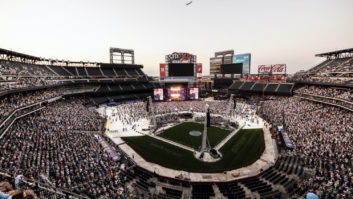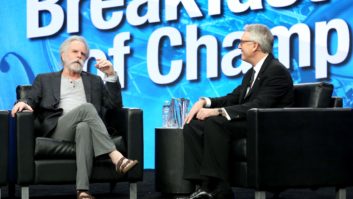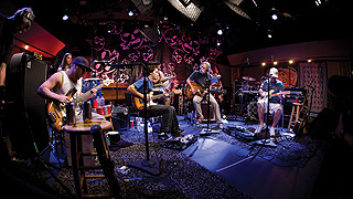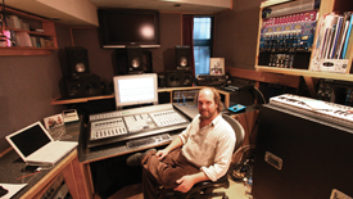ADVENTURES IN THE DOGHOUSEThis time it was going to be different. Bob Weir, the former Grateful Dead guitarist/singer, was going to work quickly in the studio, not fuss too much over minutiae, not give in to the “legendary studiophobia,” as he once called it, that seemed to grip the Grateful Dead every time they tried to make a record. When I went up to Weir’s lovely, sylvan Mill Valley, Calif., home studio in March 1999, the new album by Weir’s current band, Ratdog, was half finished by his estimation, and he was looking to have the record done by May ’99, in time for a planned summer-fall tour. At that point, the group had been cutting at a furious clip, recording basics for more than a dozen songs and still working on writing and arrangements for another ten. “We’ve actually got some momentum going here,” Weir said with a laugh, as if even he couldn’t believe that he could make a record so painlessly. His confidence was downright infectious.
But let’s not get carried away. Fast forward to June 2000. The CD is almost finished – no, really, this time it’s true! Weir’s engineer Mike McGinn and veteran engineer/mixer Tom Flye are doing some final tweaking on mixes at the Grateful Dead’s studio in Novato, Calif. McGinn has a Pro Tools setup on one side of the control room while Flye sits at the Neve VR console, and they do a little cosmetic work on Weir’s lead vocal on a fine tune called “Lucky Enough.” A flat note is pitched successfully, and Flye experiments with a couple of light reverbs to bring a little more depth to the vocal. With several of the ten songs on the disc hovering at around ten minutes or more, there might have to be a little editing before all is said and done, but McGinn is confident that can be achieved without sacrificing the integrity of any of the performances. They will make the deadline – the CD, Evening Moods, was released September 28.
During the intervening year-plus, the project succumbed to numerous delays for various personal and professional reasons. In the spring of ’99, Weir married his longtime love (and mother of his impossibly cute daughter, Shala Monet Weir), Natascha, and then that summer he decided that he wanted to do more recording, but after Ratdog’s fall tour – in keeping with the Grateful Dead’s tradition, he felt that the new songs would benefit from being tested on the road before committing to final versions on tape. And, indeed, a number of the songs did change a bit as the band played them over the course of a tour. So the day after Ratdog’s tour ended, the group went in for a week of sessions at Coast Recorders in San Francisco, and that yielded about half the basics used on the record; the other half came from the original sessions at Weir’s studio, which he affectionately calls “The Doghouse” these days.
Of the Coast sessions, Weir comments, “I felt like we needed to get out of any kind of comfortable environment and go somewhere where we had to be concise and to the point – show up and play, rather than discuss things or try a million different things without regard to how much time it’s taking. It gets you to work a little differently. The comfort level at my place, and even at Bel Marin [the Dead’s studio] is maybe a little too high, at least for basics. For basics, you want to get momentum. And comfort and momentum are sort of at odds with each other.”
Overdubs were cut at Weir’s and at the Dead’s studio. Then, around New Year’s, Ratdog sax man Dave Ellis left the group, which changed the final equation somewhat, too. Ellis, who was instrumental in the initial writing and arrangement sessions, still appears on several tracks, but as a guest. Also guesting on the album are current Ratdog sax player Kenny Brooks, former Ratdog member Matthew Kelly and ex-Grateful Dead drummer Mickey Hart, who still occasionally tours with Weir in the Deadish group, The Other Ones.
Though Weir is the unquestioned leader of Ratdog – he’s the lead singer, and the bulk of the group’s repertoire is made up of songs he wrote for the Grateful Dead and his various earlier solo albums, as well as a few Dead-associated blues and rock covers and a number of tunes originally sung by Jerry Garcia in the Dead – Ratdog is definitely more than just a Bob Weir vanity project. The group has been together more than five years – dating back to before Jerry Garcia’s death in 1995 – and the core of Weir, bassist extraordinaire Rob Wasserman and drummer Jay Lane are a remarkably diverse and flexible unit with a distinctive personality. Keyboardist Jeff Chimenti is a solid writer and arranger and a superb colorist, and a more recent addition, guitarist Mark Karan, brings a deft melodic touch to a band already filled with great rhythm players. There was deep collaboration on this CD; a necessity since Weir is such a notoriously slow writer.
“It’s more of a band record than a Bob Weir record,” comments Mike McGinn. “The band has been involved in a lot of the writing, and they’ll come in and spark things. Like the song `Two Djinn,’ Jeff Chimenti came up with the spark for that. And to give credit where it’s due, a lot of the spark also came from Jay Lane. He’s quite a good writer and he has a lot of spontaneous energy and he really understands pop form, so for the first couple of weeks, he was coming in and going over to the keyboard and generating ideas, which Jeff would maybe make into something. Bob also started a bunch of the songs, too, but everyone’s been participating. It was my idea to bring everyone in and just throw things up against the wall and see what sticks. We were placing down skeletal structures of one or two songs a day. Tape is cheap. We threw things down spontaneously and then whoever had a notion of an idea, we’d work on it right then. We wanted to make it inviting for Bob. It really energized him and he seems to be having fun. It didn’t seem quite so much like work to him as it has in the past.”
McGinn has been working freelance for Weir for the last couple of years. A native of the South Bay area of Northern California, McGinn played in various indie bands and started a 16-track studio called Bridget Sound, which is where he cut his teeth as an engineer. “I come out of the Steve Albini approach,” he says referring to the engineer of many indie rock classics. “Just document it and don’t spend a lot of time overdubbing. A lot of Albini’s ideas are just old-school ideas that he’s reapplied to a modern aesthetic. It’s all about capturing that energy; trying to keep it immediate, as opposed to fussing over every little detail. And I tried to bring some of that approach to this project.” McGinn first connected with Weir when he was brought in by Weir’s former engineer Tom Paddock to help install a Sony MXP-3000 console in Weir’s studio. He worked as a second to Paddock on a number of sessions there, did maintenance and eventually moved into the engineer’s chair when Paddock left to head the Grateful Dead’s online community, www.dead.net.
Weir’s studio dates back to the fall of 1974. It was designed by Weir and Steve Barncard (engineer of the Dead’s American Beauty and many other albums), with later input from the Dead’s live sound engineer Dan Healy. “Barncard and I designed the original board that was in there,” Weir says. “Now, I’m not an electrician, to say the least, but Barncard was really, really good at all that stuff, and he was also a great teacher. At that point, I could actually read a circuit diagram, and I knew which kinds of circuitry would inherently introduce phase distortion and stuff like that. I think I’ve probably forgotten 90 percent of what he taught me,” he laughs. “Considering the budget that we had to work with, which was not real large, I think we did a good job. That first record we made here [the Dead’s Blues for Allah] didn’t sound too bad. We did the first Kingfish [an earlier solo band] record in here with that original board. Then we tossed the board. I rented a board for a while and then about ten years ago I got this puppy [the Sony], and this is a good board. It doesn’t have all the bells and whistles some boards have, but its got automated fader mutes, which is about all we really need, because we’re not running two bands a day through here. All the rest of the modules stay the same – the sax module is the sax module – so this is the perfect board for us. And the signal path in this board, by virtue of the fact that it doesn’t have all the bells and whistles, is a little less complicated and therefore a little cleaner. I think this is the best-sounding board in the Bay Area.”
The studio has a somewhat unconventional design: What was originally a cozy control room on one side could not accommodate larger consoles and was converted to a drum room many years ago. Today, the Sony console and racks and racks of equipment sit in the center of the tracking room. Typically, the band will set up all around McGinn, whose visual reference point is drummer Jay Lane in the booth. Everyone wears headphones, hearing a mix of their own design. The Dead’s old studio in nearby San Rafael, known as Club Front, also had the console in the main studio room, so Weir is used to working that way. One space-saving innovation that was new to me is a small, ceiling-mounted lighting grid that is used to hold microphones, instead of having them cluttering more floor space in the smallish room.
McGinn says that the drum room sounds surprisingly good. “I’m not a huge fan of close-miking on drums,” he notes. “I use pretty standard stuff – a 57 on the snare and toms, a D112 on the kick or maybe a 451 – but I like to get as much as I can from overheads. I’ve been using these Lomo Russian tube mics that Steve Albini turned me on to. They’re sort of like a tube 414; they sound really good.” Later in the project, he used Neumann KM54s with B.L.U.E. capsules as overheads. Keyboards and guitars are mostly recorded direct (though Weir might also have a mic on his speaker) to Studer 820 24-track with Dolby SR. McGinn and Weir both speak very highly of the Sony console’s John Hardy preamp modules. A wide range of processing is available, from Lexicon and Quantec reverbs to the popular H3000 Harmonizer and, his current favorite “toy,” the Distressor: “I wish I had four of them,” McGinn says. “You can’t get a bad sound out of them. We have an LA-2A, but I’ll use the Distressor because it sounds good and gives me flexibility without having to repatch.”
McGinn says he was initially reluctant to use Pro Tools much on the project “because I was afraid it would defer the decision-making process too long. I wanted them to commit to stuff up front. You can always re-track and change the structures. I was fighting for maintaining a spontaneous, immediate feeling, because these songs felt like they needed to be captured earlier rather than later. With Pro Tools, there’s almost no end to the amount of fussing you can do on a track, and I wasn’t sure that was a way we wanted to go.” In the end, though, they did employ a 24-bit Pro Tools setup, using it judiciously for editing and other functions, and Weir was intrigued enough by it to take a tutorial on the system himself.
Still, Weir says his preference is to try to get entire vocal takes rather than comping from multiple passes and doing minute edits on Pro Tools: “I’ve done it that other way, where it’s chopped up and put back together, and it doesn’t work as well for me. When you’re delivering a vocal, you’re telling a story. You’re conjuring, and if you start using bits and pieces of different vocals, you’re breaking the spell. I’m really insistent that we at least attempt to go straight through.”
Though the CD missed its original deadline (self-imposed, we should add; there was no record company nipping at their heels, making demands), everyone involved thinks it was worth taking the extra time to make sure it’s right. Weir’s many fans should be delighted with the finished result: The collection boasts some of his strongest writing and performances in many years, and it captures Ratdog in all its eclectic glory – bluesy on one track, rockin’ on another, sounding a little like Weather Report on a third; it’s quite a collection of moods, grooves and feelings, all just a little offbeat, like its principal creator. There isn’t much here that sounds overtly like the Grateful Dead, but that is by design, too – in fact, when I went to the Doghouse in ’99, on a bulletin board list of the songs then in-progress, one tune was annotated: “Guitar: To Jerry.”
“I would say we can get away with dropping some Grateful Dead-style licks on the second record, but not the first,” Weir comments. “On the first one, we really need to establish our own identity. I mean, we already have something of a reputation as a Dead cover band, but the fact is we’ve got to establish ourselves. How that happened, by the way, is when I first started playing with Ratdog, which was before Jerry died; it was a vacation for me from the Grateful Dead and that whole body of material. So we didn’t play very much Grateful Dead – hardly any. It was my back pages, my solo work and a lot of blues stuff, once we had Johnnie Johnson [who played piano with the band for a while]. Then Jerry died, and people wanted to hear the Grateful Dead songs. There was a hue and cry about that, so we worked up a bunch of Grateful Dead tunes. And predictably enough, people started saying we were just a Grateful Dead cover band. There’s no pleasing everybody, I’m afraid. At this point, in order to keep our own sanity, we have to write our own stuff anyway, and we finally have a stable lineup where I’m not teaching people my own songs or Grateful Dead stuff. We’ve really become a band, and I’m happy to showcase that on this record.”
Adds McGinn, “Bobby’s Grateful Dead aesthetic is always going to come through, because it’s so much of who he is as a player, so Ratdog doesn’t really need to play into it. He wanted this to sound new and I think it does. It’s definitely him, but it’s also the band and it does sound different.”




